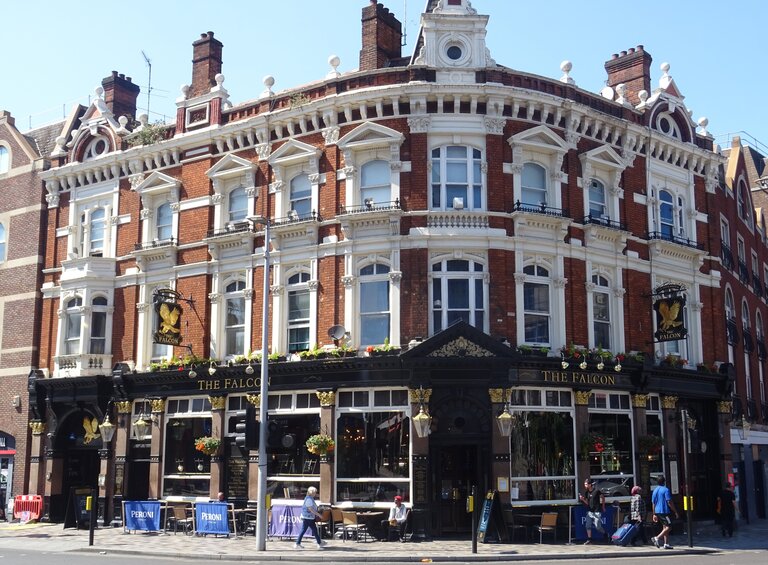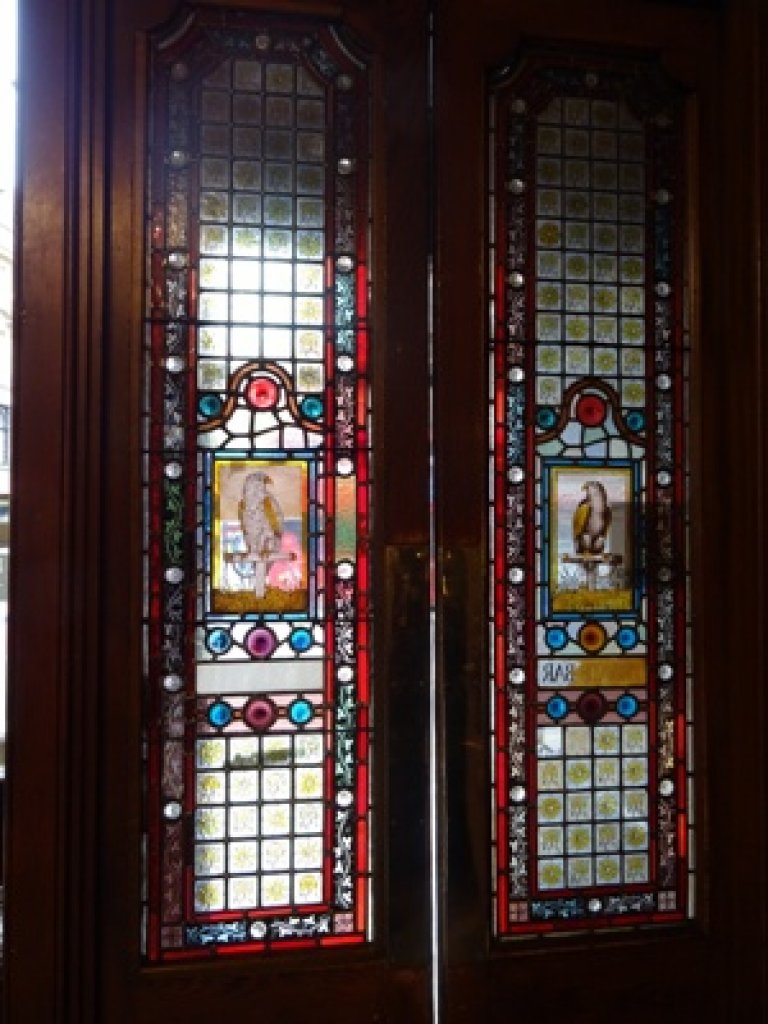Falcon
2 St. Johns HillBattersea
SW11 1RU
This pub is not only a grade II listed building, it is also a Three Star pub on the Campaign for Real Ale’s (CAMRA) National Inventory with an interior of outstanding national historic importance, and the description is as follows: “Mightily impressive pub-cum-former-hotel of 1887 with many original features, including The counter is the longest in the country at 125 ft (the runners up are the Bowland Beer Hall, Clitheroe, Lancs (105ft: modern) and the Horse Shoe, Glasgow (104ft: late Victorian). Built as a hotel-cum-pub, it is a showy building of red brick with stone enrichments and on the ground floor are stone and granite pilasters. The interior has three distinctive sections – the main part on the right is almost U-shaped and would have been sub-divided by internal partitions as there are three entrances to it; also a tiny screened ‘private bar’ on the front left and at the rear an L-shaped area restricted to diners at certain times.. There are cast iron columns with stylised Corinthian capitals painted gold. The left-hand entrance has a large lobby with a figure ‘5’ on one of the inner doors. A passage with terrazzo floor and panelled walls including a large Old Bushmill’s whiskey mirror leads to another set of double doors with deep etched and frosted ‘Billiards’ panels beyond which is a luxuriously panelled room It has panelled walls to picture frame height with a number of decorative wood carvings and pilasters with decorative capitals. On the left hand side are two short screens with stained glass panels. It is a pity about the garish modern glass in the pair of skylights. On the rear wall is a large ornate timber fire surround with modern brick infill and a plain mirror in a good wood surround above. A large stained glass window featuring some notable glass in three panes. The first features a painted depiction of the pub in its humble pre-1887 guise with the wording “The Falcon 1883’; the second shows funeral carriages stopping off at ‘Death’s Door’, the nickname for a former landlord, a Mr Death.with the wording ‘1801 Deaths Door’; and the third features a painted depiction of the present, grander manifestation and has the wording ‘The Falcon 1887’. On the right-hand side of the rear ‘dining area’ section is a curved panelled area with a doorway linking it to the rear part of the main bar. In the middle is a large serving area enclosed by a curvaceous counter which is claimed as the longest in Britain (its only real rival is the Horseshoe Bar, Drury Street, Glasgow, Scotland). This serves all three rooms with virtually identical panelled counter fronts and pillasters but the bar top in the very rear area is wider than elsewhere so may be modern and part in the rear right area looks more inter-war than Victorian. The elaborate pot-shelf on the rear right of the counter is modern work. In the centre of the servery is an enormously high bar-back with etched glass mirrors throughout including a top section held up by square pillars; fridges have replaced most of the lower bar back shelves. The stairs to the cellar also lead from within the bar back. The private bar at the front is formed by a three-quarter height timber and glass partition wall beyond which is the terrazzo floored passageway, which has a middle row of deep etched and frosted panels of a floral design and two low partitions attached to the counter. The low partitions have five narrow bays each, the middle of which is now a doorway having originally been a barrow door with good etched and frosted panels with floral designs. The large public bar has a vestibule entrance on St Johns Hill side with lovely stained glass panel depicting a falcon in the right hand inner door and a ‘Private Bar’ panel on the left hand door. The corner entrance has some deep etched and frosted panels with floral designs. History next door: Clapham Junction Station opened in 1863 and became one of the busiest railway junctions in the world (still the busiest in Britain). The area around the station is now a busy shopping district dominated by the imposing Debenham's department store (formerly Arding and Hobbs) built in 1910 to a design by James Gibson.”
The listing description is as follows: “Late 19th Century. Purpose built hotel at corner of St John's Hill and Falcon Road. Continuous frontage to both roads. With a total of 9 varied bays wide; 3 storeys plus garret. Red brick with stone enrichments. Ground floor public house facade with stone and granite pilasters. Central entrance on curve of the corner beneath semi-circular fanlight and prominent pediment. Subsidiary entrances at each end. Elaborate stone architraves to first and second floor windows. Iron window guards and stone pediments to second floor windows only. Giant pilasters with stylised Corinthian capitals run between first and second floors, supporting heavily bracketed cornice with a panelled brick parapet and stone ball decoration. The 3 entrances are accentuated at roof level by brick gables at each end decorated with stone copings and balls, and in the centre, by a truncated pyramidal roof surrounded by an iron balcony and flagstaff. Prominent chimneys. Internally rich with cut brilliant glass behind the bar display and in partitions between the bars. Leaded lights to the draught lobby, original mirrors and full-storey cast iron columns with stylised Corinthian capitals.”
The WhatPub link is here: WhatPub/Falcon
The Pub Heritage Group link is here: PHG/Falcon
The Falcon featured on the Daytime Crawl of SW17, SW18 and SW11 on 16 October 2004, the Evening Crawl of Battersea and Wandsworth on 12 December 2007, the From the Crimea to Death's Door via Cats, Birds and Breweries: Evening Crawl of Wandsworth and Battersea on 17 April 2013, and the Southern Splendour: Evening Crawl of Battersea, Wandsworth, Southfields and Earlsfield ion 11 December 2019.



